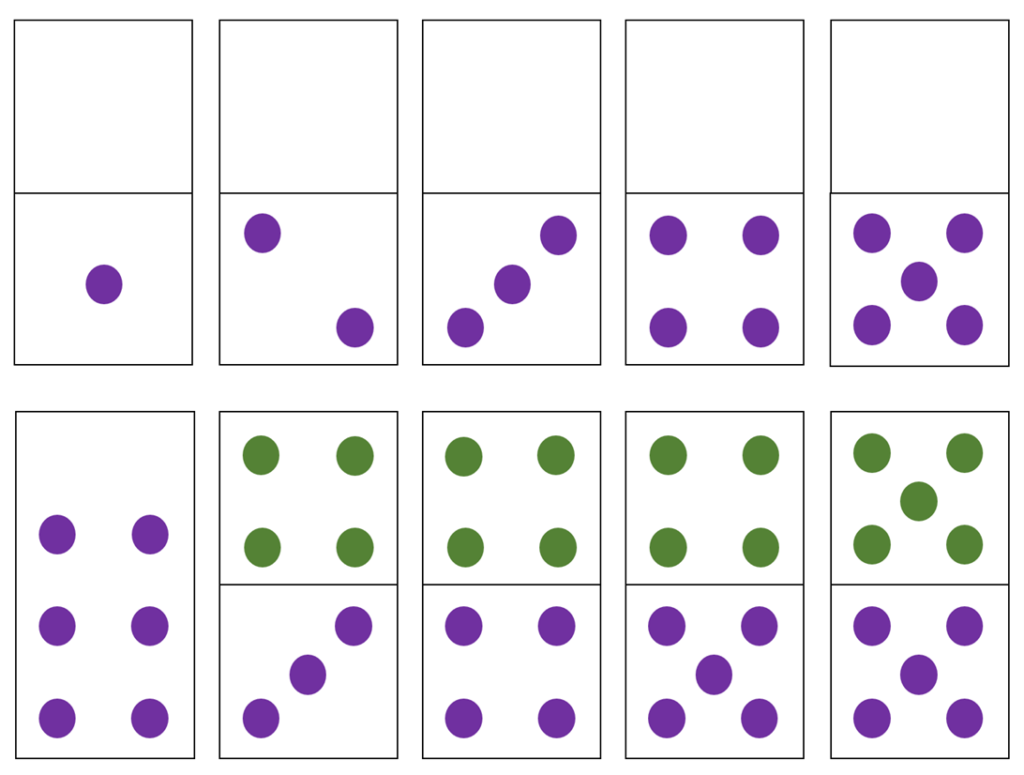What is Dyscalculia?
To understand dyscalculia, it helps to first understand our natural quantitative abilities. We are born with an innate ability to subitize, or to see small amounts and immediately know what they are, without counting. This ability extends up to about 4 or 5 and can be thought of as our exact number system.
We are also born with an innate ability to compare larger quantities and determine which is more or less, without knowing exactly how many there are. This is known as our approximate number system.
These innate abilities are housed in specific parts of the brain, and fMRI imaging has shown that people with dyscalculia may have less activation in these areas during numerical tasks.

Brian Butterworth, a cognitive neuroscientist in the UK, has led much of the current research around dyscalculia. He describes dyscalculia as difficulty enumerating small quantities (subitizing), stemming from a core deficit in the areas of the brain responsible for processing number.
In Dyscalculia: From Science to Education, Brian Butterworth writes:
“Numbers do not seem to be meaningful for dyscalculics – at least not meaningful in the way that they are for typically developing learners. They do not intuitively grasp the size of a number and its value relative to other numbers. This basic understanding underpins all work with numbers and their relationships to one another.”
It is worth noting that this research varies from what was previously thought, which is that we are all born as blank slates (Piaget), and mathematical knowledge is primarily acquired through language. I believe this line of thought impacts math education today.
As for the word dyscalculia itself, the term was originally coined by Ladislav Kosc of Czechoslovakia in 1974, whose definition still holds true:
“Difficulty in mathematics as a result of impairment to particular parts of the brain involved in mathematical function, without a general difficulty in cognitive function.”
And getting back to basics – the first question people usually have about dyscalculia is how to say it! Dyscalculia has 5 syllables and is pronounced: dis-kal-kyoo-lee-uh. It usually takes some intentional, thoughtful practice to get it down.
For more guidance on the pronounciation, as well as the signs of dyscalculia and how it affects people in their daily lives, I recommend vising Laura Jackson’s website on Discovering Dyscalculia.
What is Effective Instruction for Dyscalculia?
The heart of effective instruction for dyscalculia is the use of dot patterns, along with Cuisenaire rods and base 10 blocks. Since dyscalculia stems from a significant weakness in the ability to subitize, the needed intervention is to develop these visual patterns in the mind’s eye, using specific dot arrangements that are easiest for the brain to visualize and transfer into long-term memory.
Research is clear that subitizing is easiest when the objects are simple (dots), the foreground and background are clearly distinguishable, and the objects are arranged into standard, ideally symmetrical, 2-dimensional arrangements with no more than 3 dots in a straight line.
Since basic or “perceptual” subitizing abilities only extend to about 4 (possibly 5 or 6 when standard arrangements are used), for larger numbers it is important to use arrangements that encourage “conceptual” subitizing, or breaking the total into 2 or more parts that are easy to subitize on their own.

Dot Cards
One such example are the dot arrangements used by Chris Woodin at the Landmark School in Beverly, MA, as well as practitioners like Steve Chinn in the UK. The dots are arranged into 5-groups, with the numbers 6-10 building off the arrangements learned for 1-5. This is a powerful visual that connects to finger representations and allows students to combine 5-groups together when adding, supporting decomposition and recomposition and the all-important strategy of making 10.

Dice Cards
Another example are the dot arrangements used in the UK by practitioners such as Ronit Bird, Jane Emerson, and the late Dorian Yeo. The numbers 1-6 are the standard dice arrangements, and then 7-10 show the doubles or “near” doubles, facilitating the visual of whether each number is even or odd. A variety of dot pattern cards are available on Ronit Bird’s website.

Playing Cards
A third example is Cluster Cards, a form of playing cards developed by Mahesh Sharma in Framingham, MA. These demonstrate a more complex visual, as the objects (“pips”) have distinct shapes of their own. The cards provide more than one arrangement for some of the numbers, integrating all of the various dot patterns, and give an opportunity for students to practice through games and generalize their learning to other environments.

Cuisenaire Rods
The other highly effective tool is Cuisenaire rods, which can be used along with base 10 blocks to model larger numbers. Cuisenaire rods may seem confusing at first since they are not marked by “ones” in any way that can be counted, but that is exactly why they are so effective. The color and length of each rod varies, with the number corresponding to its length in centimeters. Cuisenaire rods help students think of numbers as “chunks” of different sizes, rather than individual items to be counted. The rods support students in moving from a discrete understanding of number as individual dots to a more continuous understanding of number as length. Cuisenaire rods can be effectively used to model addition and subtraction, multiplication and division, place value, distributive property, equations, and more.
Cuisenaire rods can be purchsed from sites like Hand2Mind and Amazon (I like this individual set). For multiplication I recommend getting at least 2 sets since there are only 4 of each of the larger rods in a set.
How can I learn more?
Take the Online Course
Decoding Math was developed as a comprehensive course intended to introduce educators to the neuroscience of math, dyscalculia, and math learning disabilities (MLD), as well as effective instructional methods for teaching number concept, addition/subtraction, multiplication/division, word problems, and fractions/decimals/place value. The course also addresses math assessments, math-related components of IEPs, and planning math interventions.
Take the Course
Watch a Free Webinar
One of the most common questions that teachers and parents have is how to help students learn math facts. Watch this free webinar (recorded August 2021) where we take a deeper dive into the neuroscience of math and discover where our current instructional approaches are misaligned with how our brains process numbers. Then be introduced to more effective methods for teaching math, developing number sense, and learning math facts!
Watch the Webinar
Get Curriculum Resources
Mathemagical Structured Numeracy is a neuroscience-based K-2 math curriculum designed to transform math instruction and build lasting number sense in students. Using visual tools like dot patterns and Cuisenaire rods, it emphasizes a structured, multisensory approach that aligns with the Science of Math to teach foundational concepts effectively. With daily lesson plans, engaging resources, and mentorship options, this program empowers educators to create confident, math-loving students. Ready to revolutionize math learning? Explore early access to this groundbreaking curriculum and mentorship opportunities today!
Get the Curriculum
Dyscalculia Resources
There are a growing number of resources about dyscalculia. Here are several I recommend:

Mahesh Sharma
Professor Mahesh Sharma is an internationally renowned expert in mathematics education, specializing in learning disabilities like dyscalculia. As the founder of the Centre for Teaching/Learning of Mathematics (USA) and Berkshire Mathematics (UK), he works globally to improve mathematics education and supports students and educators through research, publications, and teacher training. He offers regular webinars, workshops, and direct services to enhance teaching strategies and help students overcome learning challenges.
www.mathematicsforall.org
Chris Woodin
Christopher Woodin, Ed.M., is a renowned mathematics educator specializing in learning disabilities, with 38 years at Landmark School as Math Department Head and Ammerman Chair of Mathematics. An author and innovator, he created Chris Woodin’s Number Sense and has been recognized as Massachusetts LDA’s Samuel Kirk Educator of the Year. Through international presentations and WoodinMath.com, he shares his groundbreaking multimodal teaching strategies to support educators and students worldwide.
www.woodinmath.com
Brian Butterworth
Brian Butterworth, Emeritus Professor of Cognitive Neuropsychology at University College London, is a renowned expert in the neuroscience and genetics of mathematical abilities and disabilities. With a distinguished academic career, including positions at Cambridge, MIT, and the Max Planck Institute, he was elected Fellow of the British Academy in 2002. His popular science books, including The Mathematical Brain, Can Fish Count?, and Dyscalculia: From Science to Education explore the fascinating world of mathematical cognition and education.
www.mathematicalbrain.com
Dyscalculia Services
Dr. A.M. Schreuder, founder of Dyscalculia Services, is a Pediatrician and PhD in Epidemiology specializing in child development. Passionate about math, she raises awareness of dyscalculia and provides research-based interventions, tutoring, and assessments to support struggling students. Her expertise in neuro-imaging and evidence-based instruction helps her bridge medicine and education to build confidence and improve outcomes for learners. She is based in Katy, TX and offers services globally.
www.dyscalculiaservices.com
Laura Jackson
Laura M. Jackson, inspired by her daughter’s 2017 dyscalculia diagnosis, founded Discovering Dyscalculia to provide resources and support for parents, educators, and adults navigating this learning difference. She helps others understand dyscalculia and develop strategies for success. Author of Discovering Dyscalculia (2022), Laura is an international speaker, empowering families and educators with practical tools to support dyscalculic learners.
discoveringdyscalculia.com
Made for Math
Made For Math provides personalized multisensory math intervention for students with learning differences like dyscalculia, dyslexia, and ADHD. Using the Orton-Gillingham Approach and CRA method, MFM combines hands-on tools and systematic teaching to build confidence and lasting math skills. Founded in 2015 by Adrianne Meldrum, MFM offers engaging online, one-on-one sessions with manipulatives sent to families, proving every child is made for math success.
www.madeformath.com
Emerson House Learning
(Charlottesville, VA)
Emerson House provides personalized support for elementary and middle school students struggling with literacy and math, especially those with Specific Learning Difficulties like dyslexia and dyscalculia. Using research-based programs and nurturing one-on-one instruction, Emerson House builds confidence and fosters a love of learning in a welcoming, supportive environment. Located in Charlottesville, our goal is to help every child thrive.
ehlearningcharlottesville.org
Emerson House Learning
(UK)
Founded in 1991 by Jane Emerson and Dorian Yeo, Emerson House is a teaching center in Hammersmith, West London, supporting children aged 6-11 with literacy and mathematics difficulties, particularly dyslexia, dyscalculia, and dyspraxia. Through individualized, research-based programs and expert one-on-one or small group instruction, Emerson House helps students build confidence, close learning gaps, and thrive in a nurturing environment.
emersonhouse.co.uk
The Dyscalculia Network
(UK)
The Dyscalculia Network CIC provides support for dyscalculic adults, parents, and educators, offering resources, guidance, and a sense of community. Committed to raising awareness and delivering practical solutions, the network helps individuals navigate the challenges of dyscalculia and math difficulties. Whether you’re seeking expert advice, peer connections, or effective strategies, The Dyscalculia Network CIC is here to empower you!
Dyscalculia Network
Ronit Bird
Ronit Bird is a leading educator and author of books like The Dyscalculia Toolkit and The Dyscalculia Resource Book, providing practical strategies and games for dyscalculic learners. Her approach focuses on hands-on, engaging learning to help bridge concrete and abstract numeracy concepts. With experience as a teacher and SENCO, Ronit contributed to the Harrow Dyscalculia Project and continues to create resources and professional development courses for educators and parents of dyscalculic students.
www.ronitbird.com
Steve Chinn
Steve Chinn is an award-winning educator, author, and expert in math learning difficulties, including dyscalculia. He founded a pioneering school for dyslexic students in the UK and authored resources like The Trouble with Maths, a bestselling guide for educators. With decades of teaching, research, and global lecturing experience, Steve has contributed to teacher training in over 30 countries, developed diagnostic tools, and earned multiple awards. His innovative approaches continue to transform how educators support students with math difficulties.
www.stevechinn.co.ukDyscalculia Books

Dyscalculia: from Science to Education: From Science to Education
Brian Butterworth
In this ground-breaking text, Professor Butterworth explains the science of dyscalculia, highlighting its root in difficulties representing quantities accurately and swiftly, which sets it apart from other math learning challenges. Linking research to practice, he offers strategies for identifying dyscalculia and helping learners strengthen their ability to process numbers and connect them to symbols and counting. The text provides science-backed interventions and insights for effective assessment and support.
Buy the Book
Discovering Dyscalculia: One family’s journey with a math disability
Laura Jackson
Dyscalculia impacts 1 in 20 children and adults, yet it remains widely misunderstood. This math learning disability affects not only education but also everyday tasks like handling money, telling time, and performing basic calculations, often leaving individuals feeling unintelligent or defective. In this heartfelt narrative, Laura M. Jackson shares her child’s struggles with numbers, their discovery of dyscalculia, and her and her husband’s journey to support their daughter both in school and in life.
Buy the Book
The Dyscalculia Solution: A step-by-step guide to teaching children with numeracy difficulties
Jane Emerson & Patricia Babtie
The Dyscalculia Solution by Jane Emerson and Patricia Babtie builds on their award-winning Dyscalculia Assessment, offering step-by-step teaching strategies, language scripts, and activities to address numeracy challenges. Ideal for primary students but adaptable for older learners, it’s a key resource for SENCOs, TAs, educational psychologists, and teachers.
Buy the Book
The Dyscalculia Assessment: A complete teacher assessment tool for identifying maths difficulties
Jane Emerson & Patricia Babtie
Designed identify and address numeracy difficulties in students, and inform personalized teaching plans, it includes step-by-step guidance, scripts, and photocopiable assessment sheets, making it accessible for SENCOs, TAs, and teachers with or without specialist training. This fully revised second edition introduces a new design for easier use and offers insights into dyscalculia, co-occurring conditions, and behaviors to observe during assessments. Complete with games and activities to reinforce numeracy skills, it is ideal for primary students but adaptable for older learners.
Buy the Book
More Trouble with Maths: A Complete Manual to Identifying and Diagnosing Mathematical Difficulties
Steve Chinn
Combining formative and summative assessments, it features photocopiable tests, diagnostic activities, and norm-referenced tools to uncover error patterns and misconceptions, forming a basis for intervention. Updated to reflect advances in understanding learning difficulties, it addresses issues like math anxiety, vocabulary challenges, and retention problems. With sample reports, guidance on interpreting data, and low-stress presentation techniques, this resource is essential for educators aiming to accurately diagnose and support students with math difficulties.
Buy the Book
The Dyscalculia Toolkit: Supporting Learning Difficulties in Maths (Corwin Ltd)
Ronit Bird
The Dyscalculia Toolkit by Ronit Bird is a comprehensive resource designed for teachers supporting learners aged 6 to 14 who struggle with math and numbers. Packed with 220 activities and 55 games, it equips educators with practical strategies to understand dyscalculia and implement effective interventions in classrooms or at home. This fourth edition includes expanded content on dice and board games, multiplication, and division, alongside new downloadable materials like tracking sheets, activity sheets, and game boards. Updated videos further enhance its usability, making it an essential tool for supporting numeracy development.
Buy the Book